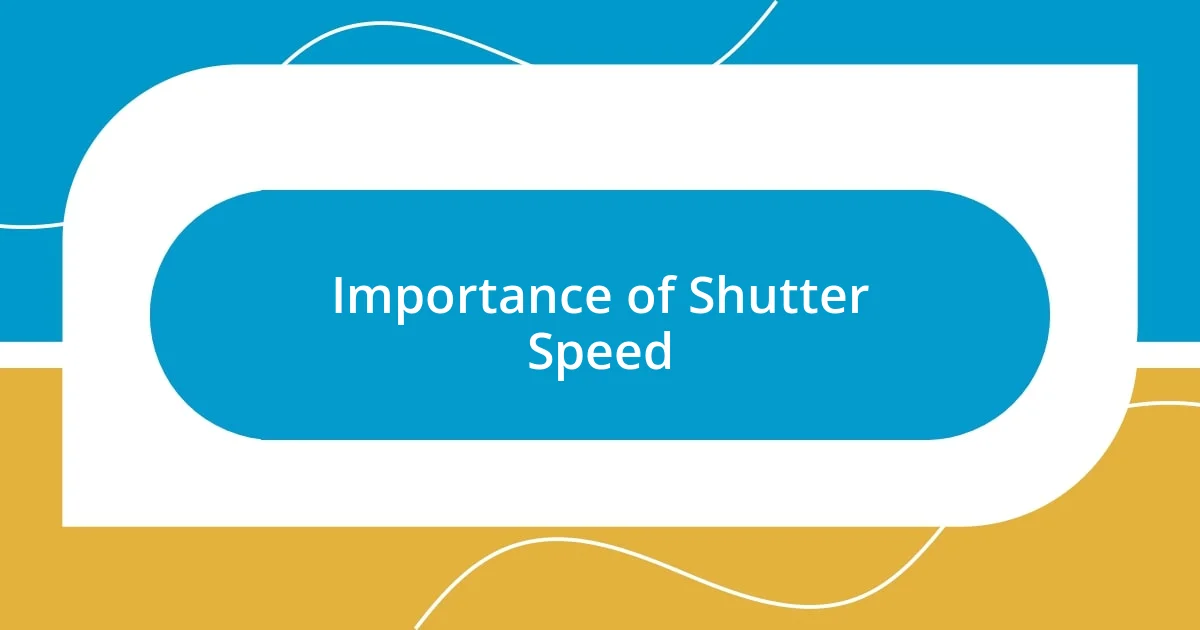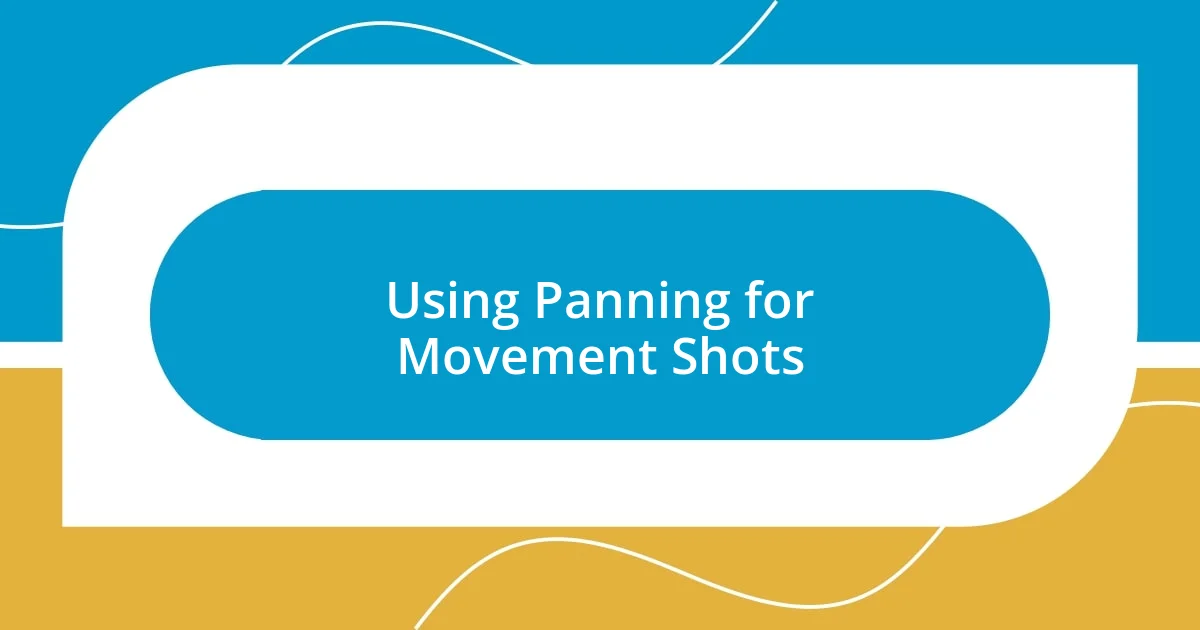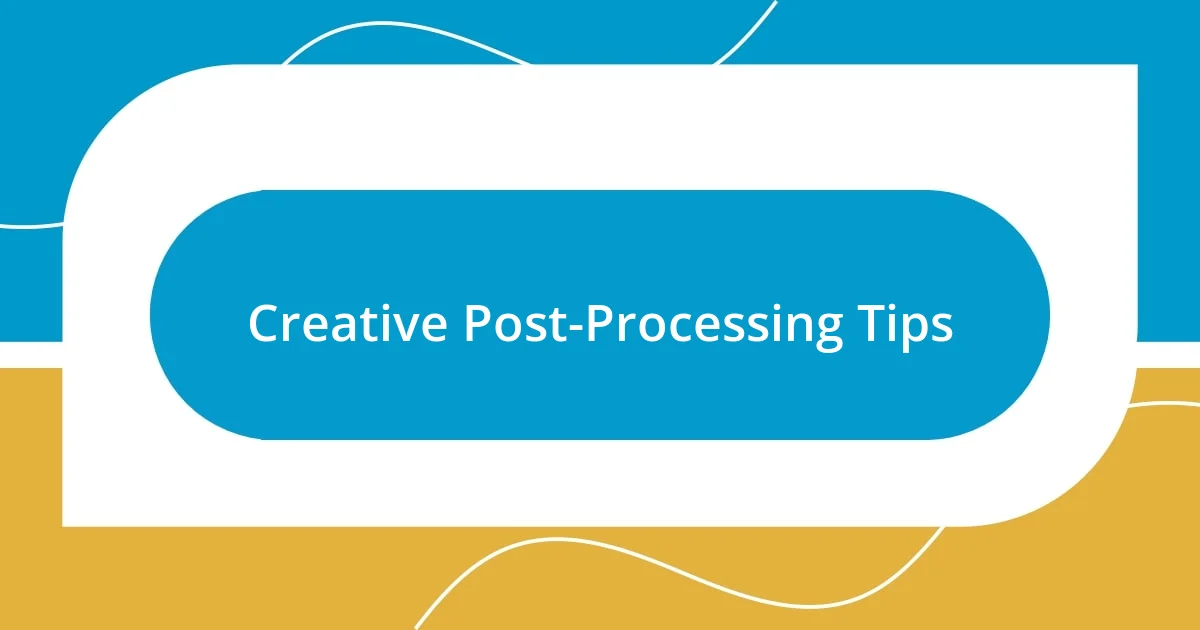Key takeaways:
- Understanding movement in photography involves using techniques like shutter speed and composition to capture energy, emotion, and story.
- Key techniques for freezing motion include high-speed photography, continuous shooting, and stabilization to ensure sharpness and clarity.
- Post-processing tools, such as color adjustment and layering textures, can enhance the mood and depth of movement shots, transforming ordinary images into impactful stories.

Understanding Movement in Photography
When I first started exploring movement in photography, I realized it goes beyond just the subject in motion. It’s about capturing the energy, the emotion, and the story unfolding in front of you. Have you ever looked back at a photo and felt the rush of that moment? That’s the kind of connection I strive to create with movement.
Understanding movement means recognizing how it affects your composition. For instance, when I photograph a dancer mid-leap, I’m not just focusing on their pose; I’m drawn to the lines created by their body and the shadow they cast. This adds depth to the photo, pulling viewers into the dance itself. Isn’t it fascinating how a single moment can invoke so many feelings?
I often play with shutter speed to either freeze motion or blur it, depending on the narrative I want to tell. In one memorable shoot of a cityscape at twilight, I used a slow shutter speed, letting the car lights streak across the frame. It transformed an ordinary street scene into a vibrant story of urban life. How do you think altering speed can change the perception of movement in your own work?

Importance of Shutter Speed
Shutter speed is one of the most critical aspects of capturing movement effectively in photography. When I think about it, I remember my early days experimenting with different speeds during a weekend trip to the beach. I aimed to capture the waves crashing against the rocks. With a fast shutter speed, the splashes were frozen in time, giving a crisp and exhilarating feel to the image. In contrast, a slower shutter speed turned those waves into a soft, flowing blur, making the scene feel dreamlike and serene. This contrast in results really amplifies how the choice of shutter speed can evoke vastly different emotions.
To really understand the importance of shutter speed, here are some key points to consider:
- Freezing Motion: A fast shutter speed can freeze action, making subjects appear sharp and defined, capturing their peak moment.
- Creating Blur: A slower shutter speed can create motion blur, conveying movement and dynamism, which can enhance the storytelling aspect of the image.
- Versatility in Style: Adjusting shutter speed allows for varied artistic expressions, going from sharp images of a sprinter in full flight to softly blurred images of a bustling city street, each telling a different story.
- Control Over Light: Shutter speed directly affects the amount of light hitting the sensor, influencing exposure and overall mood, making it essential for mastering your photographic style.
Each of these aspects has shaped how I approach my photography, teaching me to think carefully about the message I want to convey with each shot.

Techniques for Freezing Motion
When I think about techniques for freezing motion, one of the standout methods is using high-speed photography. I remember a time at a local carnival when I set up my camera to capture the moment a water balloon burst. By adjusting my camera settings to a high shutter speed, I snapped just as the balloon popped. The resultant photo immortalized the splash of water and the sheer surprise on my friend’s face, creating a moment in time that was both vibrant and full of life.
Another approach is employing continuous shooting or burst mode. I discovered this technique while photographing my dog at play. By holding down the shutter button, I was able to capture a series of images as he leaped into the air. Out of all the shots taken, one perfectly captured the joy and movement of the moment, which might have otherwise faded in a single photo. It’s thrilling to see how capturing several frames can lead to one standout shot that tells an engaging story.
Lastly, stabilizing the camera is crucial in freezing motion effectively. During a cycling event, I learned the hard way how camera shake can spoil a perfectly timed shot. After switching to a tripod, I felt more at ease in tracking the cyclists as they raced by. The sturdiness allowed me to achieve sharp images, highlighting the intensity and speed of the participants. This experience underscored the importance of technique along with gear; both can dramatically influence the captured moment.
| Technique | Description |
|---|---|
| High-Speed Photography | Utilizes fast shutter speeds to capture fleeting moments, ideal for instances like bursting balloons or splash shots. |
| Continuous Shooting/Burst Mode | Enables capturing multiple frames in quick succession to increase chances of getting the perfect shot of a moving subject. |
| Stabilization | Involves using tripods or stabilizers to minimize camera shake while tracking fast-moving subjects, ensuring sharp clarity. |

Techniques for Emphasizing Motion
One of my favorite techniques for emphasizing motion is panning. I discovered the thrill of this method while trying to capture a cyclist speeding past me on a local trail. As I adjusted my shutter speed to a slower setting and moved my camera in sync with the cyclist, I felt a rush of anticipation. The final shot showcased the cyclist crisp and sharp against a beautifully blurred background, perfectly illustrating speed. Have you ever felt like you were moving alongside your subject? That’s the magic of panning.
Another effective approach involves using leading lines in your composition. During a recent nature hike, I took advantage of a winding path leading into a vibrant sunset. I positioned myself to allow the trail to guide the viewer’s eye along with the journey, creating a sense of movement toward the horizon. It’s fascinating how even an inanimate object like a road can suggest motion, right? It’s like drawing the viewer into the journey itself, sparking a sense of adventure.
I’ve also found that playing with depth of field can emphasize movement compellingly. For instance, while at a bustling market, I focused on a vendor tossing fresh produce into the air, applying a shallow depth of field. The background became an artistic blur, honing in on the vibrant colors and energy of the action. This technique can lift your subject from the chaos, showcasing not just movement but the life and excitement surrounding it. Isn’t it incredible how a simple adjustment can transform the feel of an image?

Using Panning for Movement Shots
Panning has become one of my go-to techniques for capturing movement in photography. I remember the first time I tried it at a local car rally. As a speeding race car zoomed past, I instinctively followed its motion with my camera, adjusting my shutter speed. The photo that emerged showcased the car perfectly sharp, contrasted against a beautifully blurred background. This experience illustrated to me how panning captures not just the subject, but the very essence of speed; it’s like you can feel the adrenaline just by looking at the image.
I find that timing is everything with panning. On one occasion, while shooting a skateboarder at a park, I started to anticipate their movements. I’d noticed how they would pop off the ramp and grind along the rail, so I adjusted my stance and followed them seamlessly. The result? A dynamic shot that felt alive, as if the skateboarder was leaping off the page. Isn’t it fascinating how, with the right technique, you can transport viewers into that moment? It’s like they’re right there, part of the action.
When I think about the challenges of panning, I can’t help but recall moments of frustration when things didn’t quite go right. I once misjudged the speed of an oncoming subject during a local marathon. I was so eager to get the shot that I didn’t give myself enough time to adjust. The result? A blurry mess! However, what I learned that day was invaluable. Panning requires patience and practice, and each failed attempt only brings you closer to mastering the art. After that, I made it a point to practice, knowing that each click of the shutter is a step toward capturing that perfect movement shot. How about you? Have you ever felt the thrill of getting it just right after several attempts?

Best Equipment for Capturing Movement
When it comes to capturing movement, the right equipment makes a world of difference. I fondly remember my first experience with a fast prime lens. I was at a music festival, and as the band performed, my 50mm f/1.8 lens allowed me to freeze the lead guitarist in mid-solo with stunning clarity. The light gathered beautifully, and I could adjust the aperture quickly, ensuring sharp images even in low light. Have you ever felt that rush when you click the shutter and know you’ve captured something special?
Stabilization tools can also enhance your ability to photograph movement. I recall using a gimbal for the first time during a dance performance. It was extraordinary to follow the dancers’ fluid movements without losing focus, creating a video that felt almost like a dream. If you want to capture dynamic scenes, having a gimbal not only stabilizes your shots but also opens up creative possibilities. Doesn’t it feel empowering to have the right tools that enable you to tell your story effortlessly?
Lastly, let’s not overlook the importance of a good camera body. I made the switch to a full-frame DSLR after feeling limited by my previous gear during a winter sports event. The fast autofocus and burst shooting mode were game-changers. I vividly remember catching a snowboarder catching air off a ramp; the sharp details were mesmerizing. Investing in a camera that handles movement well can significantly elevate your work. Have you experienced how a simple upgrade can transform your photography journey?

Creative Post-Processing Tips
Adjusting colors and contrast can profoundly influence the mood of your movement shots. I remember one time I captured a runner in a city marathon; the raw energy was palpable, but the original colors felt flat. After playing around with the curves and bringing out the vibrancy in the reds and greens, the photo transformed. Suddenly, the image screamed energy and excitement, making viewers feel the pulse of the event. Have you ever experienced that moment when post-processing turned an ordinary shot into something remarkable?
Layering textures and elements can also add depth to your images. On a recent trip to a botanical garden, I had a lovely photo of a dancer twirling among the flowers. By blending in a subtle texture overlay of leaves and petals, I created a dreamy effect. It felt as if the dancer and nature had merged into one harmonious dance. Doesn’t it feel rewarding when post-processing allows you to push creative boundaries and tell a richer story?
Experimenting with motion blur is another effective technique. I recall attending a street fair filled with vibrant life and movement. I decided to add intentional blur to some spinning rides while keeping the spectators sharp. The result was captivating; the combination conveyed both excitement and stillness. Have you thought about how adding a touch of blur might evoke emotion and amplify the narrative of your movement shots?














